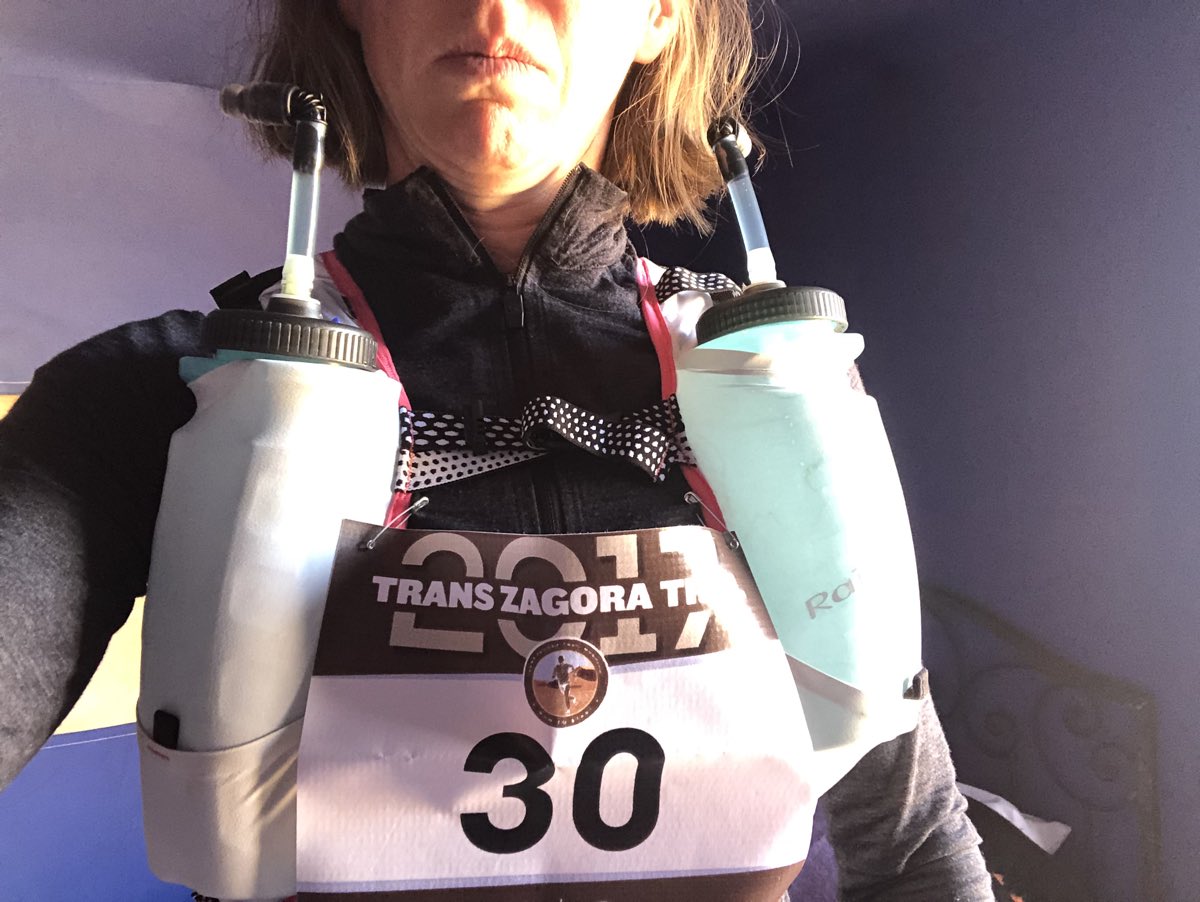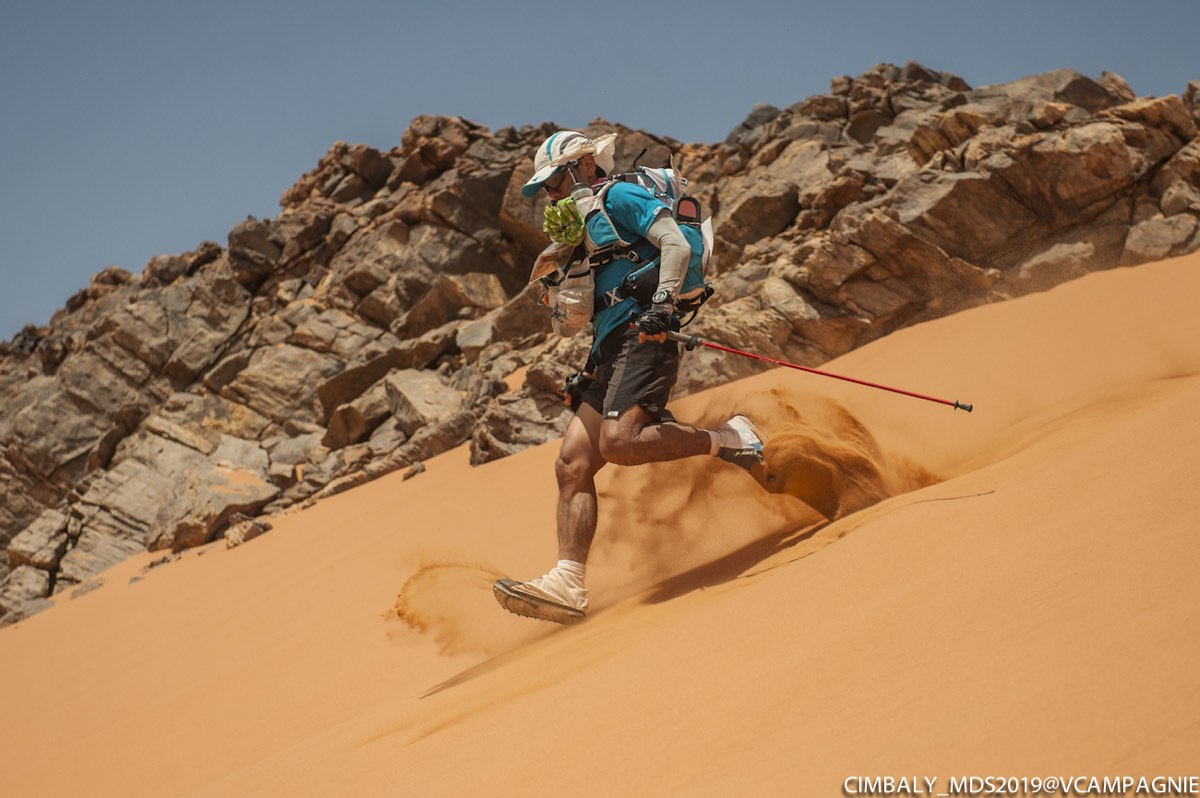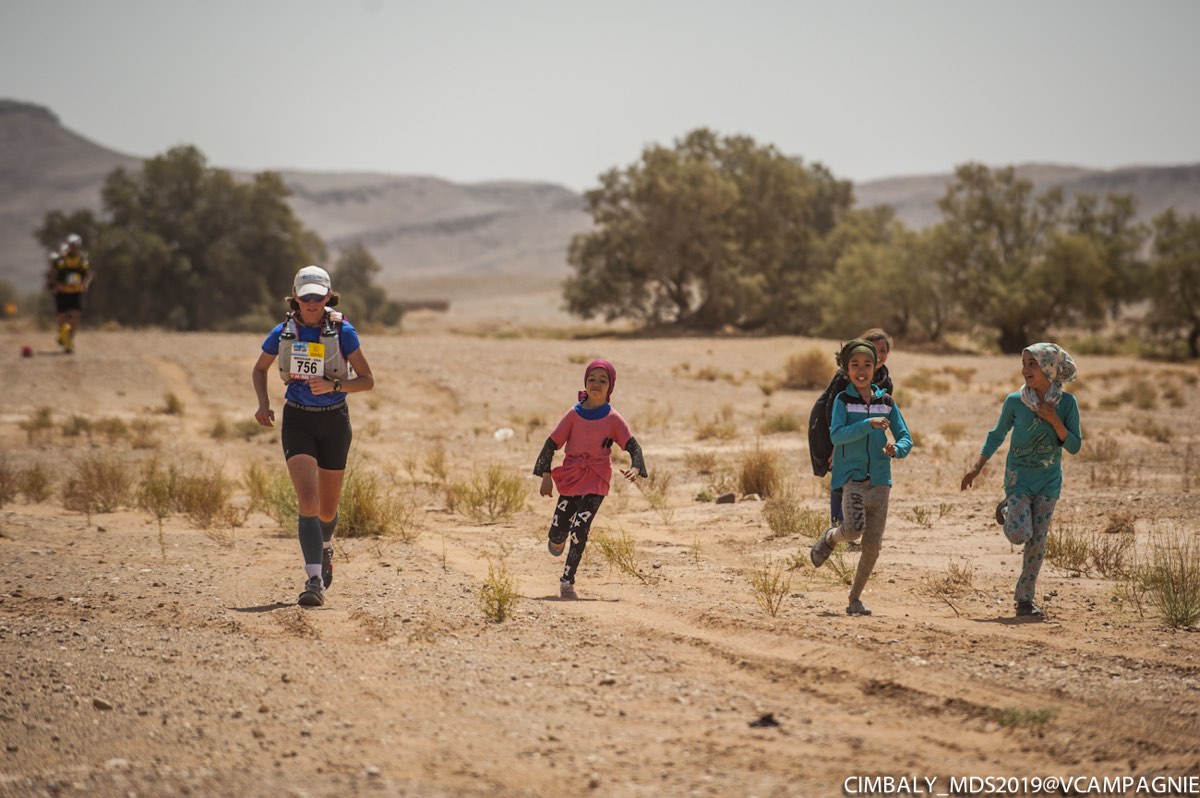Congratulations, you’ve decided to run the Marathon Des Sables, a weeklong, self-sufficiency stage race in Morocco! This is a big decision for a number of reasons, let alone the incredible, life-altering week you’ll have in the Sahara Desert. Between the resources you put into the trip itself and your preparation for it, the Marathon Des Sables (MDS) captures a lot of your wallet and time. I have now run the MDS six times, so I clearly think the commitment is worth it.
What I have learned over the years is that the more committed you are to the pre-race and during-race MDS experience, the better it will be. By ‘better,’ I mean that you will feel physically better and have more fun. This goes for preparing your kit, food, training, and logistics. I’ve made a lot of massive mistakes out there over the years and I’ve seen others make big ones, too. In almost every case, our mistakes could have been prevented with preparation beforehand.
This article is part one of a three-article series where we offer detailed information on how to prepare for and run MDS. This article focuses on preparing your kit, which refers to all of the gear you carry and wear during the race. Part two is about preparing your food and in part three we write about training and logistics. While we write specifically about the MDS experience, a lot of what you’ll find in this article series can be applied in theory to other expedition-length, self-sufficiency stage races, too.
In this article, we begin by talking about the basic principles of preparing your MDS kit, and then dive into detailed recommendations as well as my own kit list.
Marathon Des Sables Kit Principles
When we talk about MDS kit, we are referring to all the gear that you carry and wear during the race. This includes the mandatory kit you are required to carry by the race organization as well as the additional kit you choose to bring. Here are the five basic principles I think best guide choosing and using MDS kit:
- Follow the race rules.
- Lightness is queen/king.
- Pre-test everything.
- Bring no more than four luxury items, maybe just two.
- You are a study of one.
Follow the Race Rules
There are a lot of rules for the MDS! Some rules have been steadfast over the decade I’ve been racing MDS, and a few are modified from year to year. Each year before the race, it’s felt like a project to sit down, read the regulations, and create my kit in adherence of them.
Over my years at MDS, I have seen a lot of people not following the rules, both unintentionally and intentionally, though predominantly the former. Rules exist for multiple reasons, to ensure our safety and, since it’s a race of self-sufficiency where all participants are reliant on what they’ve brought in their pack, to create a level playing field among us all. The way I see it, if you do not like the rules of a particular game, don’t play that game.
Once you also read the rules, you will see that there are also a lot of penalties which can be given for not following them. I have observed that the race organization is strict in assessing penalties for breaking kit rules.
Lightness is Queen/King
No matter where in the pack you think you will run, how much weight you can push around in the gym, or your overall body mass, the weight of your kit is so important. You will lug all of it an estimated 250 kilometers (155 miles) for a week across sand dunes, over mountains, and through oppressive heat. Having a pack that is too heavy contributes to overall fatigue, causes blisters and injuries, and is simply not fun.
In 2019, the race rules stated that your pack should weigh between 6.5 and 15 kilograms (about 14.4 and 33 pounds) at the start of the race. This mandated weight range includes all of the mandatory kit you are given by the race organization at check-in and does not include water.
It’s difficult but possible to start the race with the minimum weight of 6.5kg. To meet this low weight, you have to count every gram you put into your pack and make significant luxury-item sacrifices. I have also observed that the race’s fastest runners, the Moroccan men, typically start the race with packs weighing about 7kg. Occasionally, you will see frontrunner women and one or two men start the race with 6.5kg.
While each year there are a number of people who carry huge packs that weigh 10, 12, or even 15kg, I will argue that there is never a reason to carry a pack over 8.5kg. With 8.5kg and kit preparation ahead of time, you can carry everything you need plus many things you want.
In my six MDS runs, I have started with between 6.5 and 6.9kg.
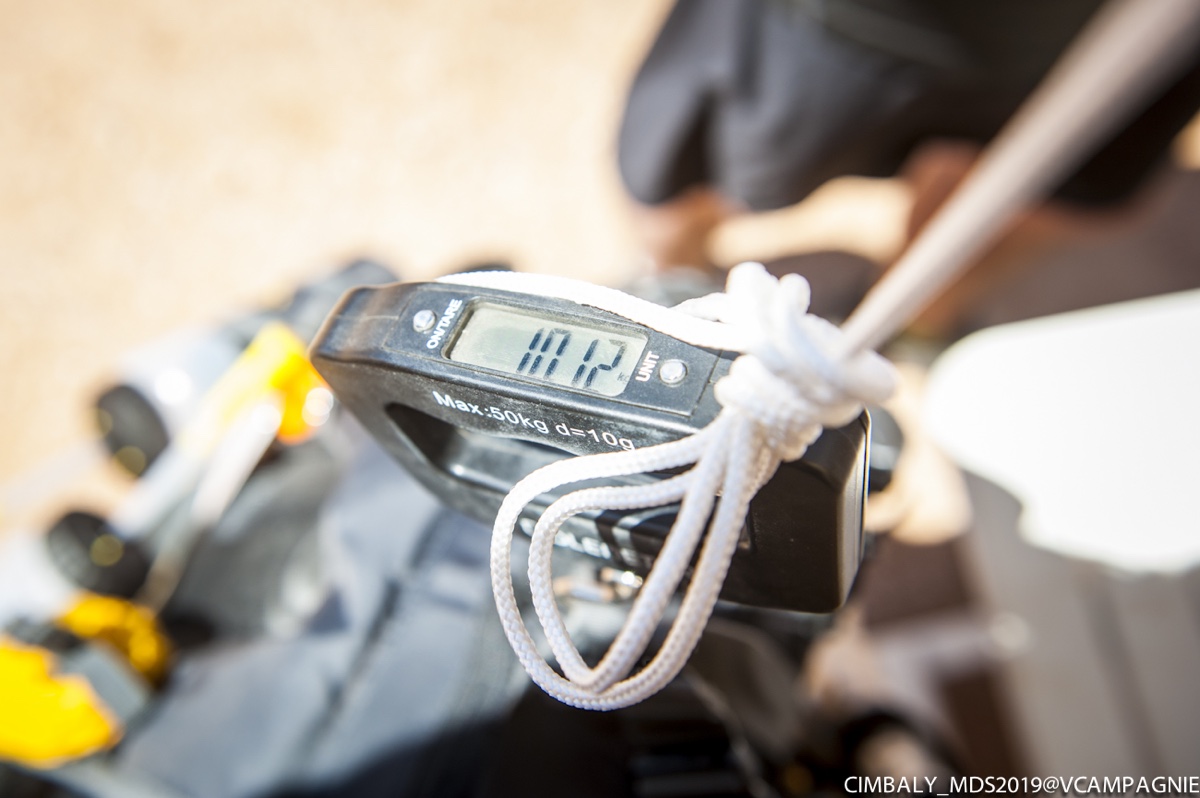
A pack being weighed at the 2019 Marathon des Sables check-in. Ten kilograms is too heavy! Photo: Cimbaly_2019@VCampagnie
Pre-Test Everything
Simply said, when you fire off from the MDS start line, there should be nothing in your pack or on your body that you haven’t tested!
Most of MDS’s conditions can be temporarily replicated wherever you live and train. Heat? You can find it in a sauna, a heat-training center, or by wearing far too many clothes. Sand? Sandy terrain can be at least partially replicated on any soft surface, including beach sand, thick grass, and snow. Pack and race clothing wet with sweat? Douse your gear with water and get running. Cool overnight temperatures and hard surfaces for sleeping? Create these sleeping conditions in a closet, storage room, or, in some places, your backyard.
In 2019, I discovered that a storage room on the exterior of my house had the same overnight low temperature that I would find at MDS. In it, I tested three different combinations of sleeping bags and insulating clothes pre-race.
Bring No More Than Four Luxury Items, Maybe Just Two
What is a ‘luxury item?’ I define it as anything you don’t actually need to complete the race. Luxury items are things you want, that you think will enhance your experience and are worth the weight of carrying them all week. How do you determine what you need versus what you want at MDS, especially if you haven’t run it before? Refer back to the third principle of pre-testing!
Some examples what I consider to be MDS luxury items include:
- more food than the minimum required by the race organization;
- sleeping pad;
- change of clothes for camp (in excess of what you’ve determined you need to stay warm);
- GPS running watch; and
- stuffed animals, cards from your family, music, camera, your nation’s flag, a sign representing the charity you’re running for, a costume, or lipstick.
I recommend that you bring no more than four luxury items, and perhaps just two. Any more than four items and your kit will become heavy. While our wants vary, I have found over the years that the most physically meaningful luxury items for the most people are the first three bullet points: extra food, a sleeping pad, and a change of clothes in camp. The fourth and fifth bullet points I consider to be mentally meaningful luxury items, that which can boost you psychologically.
In my six runs at MDS, I have always carried one luxury item, extra food. A couple times I have carried music, and once I carried a sleeping pad.
You Are a Study of One
Your kit is your kit, my kit is my kit, and George’s kit is George’s kit. What ends up on your kit list should be the result of the pre-testing you do and not what your friend is bringing, what you read about in this article, or what you saw in a MDS Facebook group. Consider all of the information you gather from these resources to be invaluable in terms of showing what options are available, but every item on your kit list should pass your own pre-testing.
As an example, a few years ago, I learned that some people use paper towels in lieu of toilet paper while camping because they are more durable and sanitary–specifically less subject to blowing away or ripping in the wind and better able to protect your hand from your ass. While this sounded like a good idea in theory, I worried about the roughness factor. For a week at home, I used paper towels instead of toilet paper, learned that my body tolerates them just fine, and now include them in my MDS kit.
Race Organization Mandatory Kit
I’ve created a public Google Sheet containing my 2019 MDS kit. I’ve also embedded it in its entirety at the close of this article. Through the rest of this article, I also include screenshots of each major section of kit. Notice that my original Google Sheet contains a ‘Notes’ column for each section, but that’s not included in the screenshots since some of them are quite long.
We begin with all of the race organization’s mandatory kit, some of which are incredibly obvious and others of which are certain to make you chuckle.
Backpack
Choosing one’s MDS backpack is perhaps the most important choice you make–after signing up for the race itself! You spend hours with this thing strapped to you each day of the race, let alone all the training hours you do with it beforehand.
First and foremost, choose a pack that’s designed for running, in the 22-t0-25-liter range, and that feels food on your body when running. Running packs are designed to distribute the pack’s weight on your shoulders, ribcage, and the narrowest part of your torso (your waist). Packs designed for hiking or backpacking normally distribute a lot of their weight to the widest part of the torso (your hips). When you use this kind of pack for running, it rides up toward your waist. When testing possible MDS packs, run with a volume and weight that represents both the beginning and end of the race, the heaviest/biggest and the lightest/smallest your pack will be. You want a pack that stays put on your back, with no bounce or sway. You also seek a pack with no pinch points on your body, that hits a collarbone funny or pulls on your belly flesh.
One of the critical choices you will need to make as you choose your MDS pack is how to store your water on/in it. At MDS, water is given out in 1.5-liter disposable bottles both at checkpoints during the stages and when you arrive to the finish line of each stage. At some checkpoints, you are given 1.5 liters only, while at others they offer you three liters. You’ll need to decide whether you want to use and wear somewhere on your pack the 1.5-liter bottles the organization gives out or to pour that water into your own water bottles worn somewhere on your pack.
Did you notice that I haven’t mentioned water bladders or softflasks? A small number of people use these devices, which are currently exceedingly popular in regular trail running and ultrarunning, during MDS. It’s a risk, though, to depend on a soft-sided bottle for a week in the sharp and thorny Sahara Desert. Also, using a bladder in a pack full of kit is a lot harder than doing the same with the racing vests we use at day-long events. I don’t currently recommend using bladders and softflasks at MDS.
Next, consider access points for the things you will need while you are running like food, drink mixes, a compass, and a flashlight. Some packs specifically designed for MDS contain some sort of front pouch. The goal of these front pouches can be two-fold if they work correctly, to allow you access to more than the generally small amount of stuff you can store in the front pockets of other running packs and to distribute some of the pack’s weight to the front of your body.
Last, consider the weight of your potential MDS pack–the weight of it alone on a scale with nothing in it. There are a lot of packs out there, and several MDS-specific packs, that are overbuilt. They contain bells and whistles that no one needs and that add up to wasted weight. You will hear me say this over and over, but be ruthless with weight!
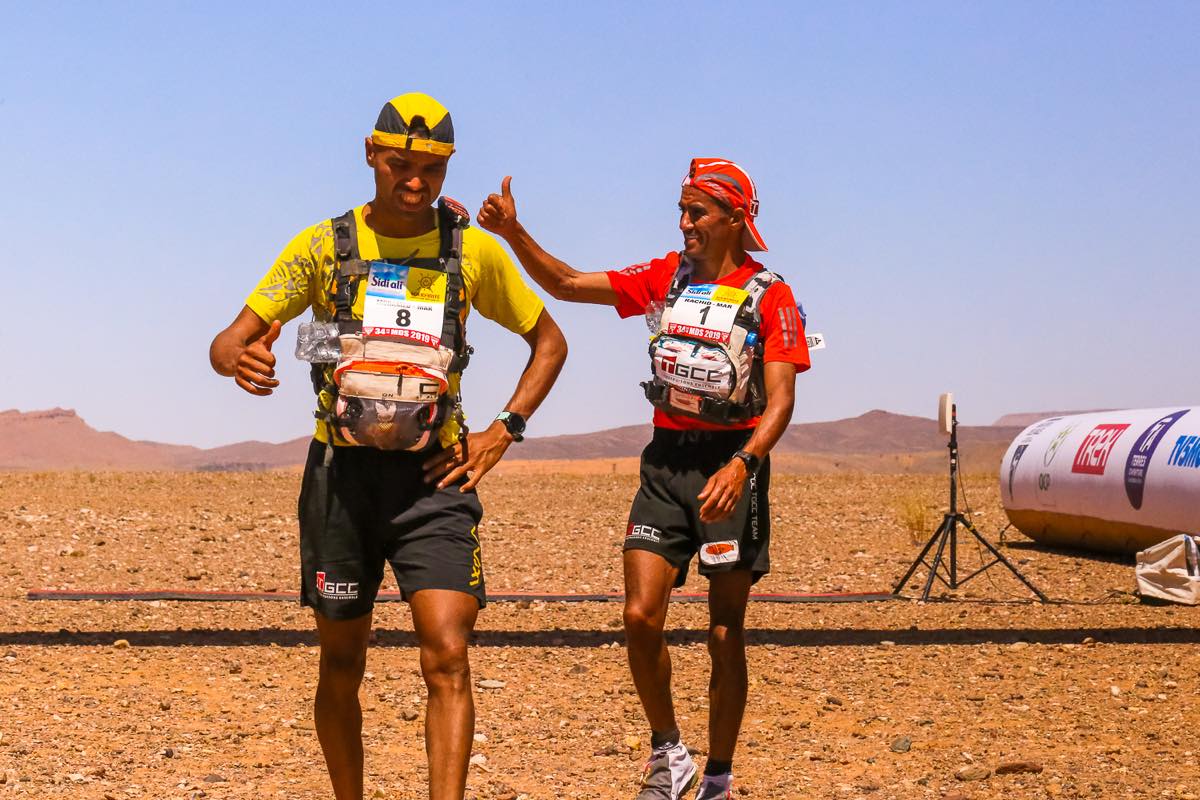
Rachid (right) and Mohamed El Morabity in their MDS backpacks with included front pouches and storage for the water bottles given out by the race. Rachid and Mohamed respectively finished first and second at the 2019 MDS. Photo: Photo: Cimbaly_2019@Cova
Sleeping Bag
MDS takes place in April, which is spring in the Sahara Desert. This means that nighttime temperatures can range from about 10 to 20 degrees Celsius (50 to 70 Fahrenheit). Often it’s windy in the spring, which can make it feel colder. While a sleeping bag is mandatory kit and insulating clothing isn’t, some people use a combination of a sleeping bag and insulating clothing for versatility in both hanging around in camp and sleeping.
I can’t emphasize enough the importance of testing potential sleeping bags (and insulating clothing) ahead of time. Find a place around or in your home with the right temperature and do a campout. Additionally, runners can test their sleep set-ups for one night in the Sahara Desert ahead of the race! Runners arrive to the start-line campsite on Friday, check in on Saturday, and start racing on Sunday. At check-in, you turn in to the race organization any excess luggage you traveled with for safekeeping. You can bring multiple options, test one on Friday night, and adjust as needed.
Headtorch
You will use your headtorch at camp each evening and during the long Stage 4, which is usually around 80 kilometers (50 miles) in length. In camp, 10 lumens is plenty for seeing your food to eat, messing around with your kit, and visiting the bathroom. Three hundred lumens is currently recommended for normal trail running and ultrarunning scenarios. However, I would argue that 300 lumens is generally excessive at MDS, for several reasons. First, the terrain is generally wide open with no curvy, twisty singletrack and no enclosed forest. The slower you go, the less light you need, and most everyone travels pretty slow during Stage 4. Next, the MDS route markings at night, glow sticks on posts, are categorically excellent. Finally, more lumens generally means more weight to carry.
Other Mandatory Kit
Be ruthless with the weight of your other mandatory kit! For example, you don’t need a massive signalling mirror and you certainly don’t need a full Swiss Army Knife. What you need is a couple-inch mirror that reflects well in sunlight and a good cutting blade, and you can garner such things in devices that weigh only a few grams. Again, test your equipment at home, count grams carefully, and save useless weight.
Other Kit
Here we arrive to the second major kit section. This is the kit that isn’t mandatory, but that you decide you either need or want. To clarify ‘need’ and ‘want’ in the context of MDS, we refer back to the basic MDS kit principles. Needed kit is what you specifically have to have in order to finish MDS, and wanted kit are luxury items which aren’t necessary but that enhance your experience physically and/or mentally.
Water Bottles
As you choose which backpack to use, you will also be choosing how and where on your pack you carry the water rationed to you by the race organization. For some people, this means bringing your own water bottles. Please refer to the earlier backpack section for more details.
Another detail to consider in choosing water bottles is how you will access them to drink. Due to MDS’s heat, you drink a lot more water than in most trail running and ultrarunning scenarios and therefore access your water frequently. Many people at MDS choose to carry bottles with straws on the front of their body so that they can drink without moving them over and over.
Insulating Clothing
We previously addressed expected low temperatures for April in the Sahara Desert, and we also wrote about how some people combine their (mandatory) sleeping bag and (non-mandatory) insulating clothing to create versatility for hanging around camp and sleeping. Please see the sleeping bag section above.
Toiletries and Toilet Paper
When it comes to choosing your toiletries and toilet paper for MDS, my motto is to expect the unexpected. Expect that you will have to poop three times a day. Expect that the wind will blow away one of your contacts as you’re putting it in. Expect to begin your menstrual cycle early. You still can pack for a number of unexpected scenarios via adding only a few grams of weight, so be careful but ready.
At MDS, you will become dirtier than you have ever been. The wind carries dirt everywhere. No matter how dirty your body becomes, clean hands will help keep you healthy all week. Develop a process for how to clean your hands after using the bathroom and before eating. I additionally have a rule of not shaking hands with anyone at MDS so that I keep my germs to myself and vice versa–hugs and fist bumps are in play, though!
And one more time, because it can’t be said enough: bring more toilet paper than you think you’ll need.
First Aid/Gear Repair/Foot Care Kit
The race organization’a medical team, called Doc Trotters, is an incredible group of women and men who are ready to treat almost every medical issue, from minor problems to life-threatening situations. That said, it can be time consuming to visit them for minor medical issues such as to have a blister popped. The line can be long and you may have to wait in the hot sun. You can treat minor issues yourself at the cost of only a few grams in your kit!
In prepping a self-built kit for first aid, gear repair, and foot care, again, expect the unexpected. Expect that you might get an illness or a migraine. Expect the side of your pack to rip on a thorny bush. Expect to get blisters even if you’ve never had them before. Expect the niggle you had during training to return in earnest. Once again, this isn’t reason to load up with a lot of extra weight–a length of duct tape, dental floss, and a needle weigh only a few grams and can repair almost any gear issue–but a reminder to be intentional. Once you are out there at MDS, it’s just you and what’s in your pack for a whole week. Make sure you have what you need!
Food
The race organization mandates you to carry a minimum of 14,000 kilocalories of food, or a minimum of 2,000kcal per day. The organization further requires you to maintain a minimum calorie count on the morning of each stage, explained in a chart in the race rules. This includes still having 2,000kcal when you wake up in the morning of the seventh day/the sixth (charity) stage.
We will devote an entire article in this series, to publish soon, on planning your MDS food. Stay tuned!
Other Organization Mandatory Kit for Race Check-In
This is the other kit that the race organization requires you to present at check-in, your medical form and electrocardiogram (ECG) tracing. The race requires you to visit a doctor during a window of time pre-race for a physical and ECG. Carefully follow the race organization’s instructions as you carry out these tests with your doctor. The race organization collects these two forms from you during race check-in, so you don’t carry them for the week.
Kit Worn on Body While Running
We’ve made it this far and yet there’s still so much important kit to consider, what you will wear on your body as you run!
Gaiters, Socks, and Shoes
What you put on your feet for MDS is just as important as the backpack you choose–incredibly important! To start, you must use gaiters that fully cover your shoes’ uppers and the opening of your shoe around your ankle. You will regularly encounter ankle-deep sand. Gaiters designed to cover the whole shoe and ankle are typically made with velcro at their bottom. You attach an opposing piece of velcro all the way around your shoe, where the upper and midsole meet, which allows you to seamlessly attach your gaiters to your shoe. I highly recommend hiring a professional cobbler to do this, and I recommend you instructing her/him to attach the velcro to your shoes via both sewing and shoe glue. I’ve seen glue unstick and I’ve seen sand sneak in around stitch marks, but I’ve never seen the combination fail.
While the gaiter situation is universal, running sock and shoe choice are incredibly individual. As I have said so many times in this article, test! First, consider your shoes’ protective qualities. Is there a rock plate, a thick midsole, or a burly outsole in your shoes? The terrain at MDS is generally pretty rocky and this combined with carrying so much pack and water weight all week can beat your feet up. Next, breathability. Your feet generate a lot of sweat in MDS’s hot climate, and you’ll find that the gaiters leave your feet hotter and sweatier than normal. What sock/shoe combination transfers the most heat and sweat away from your foot skin and to the outer part of your shoe? Now, sizing. I have heard many recommendations for MDS runners to size up their shoes a half to a whole size in order to accommodate foot swelling and/or the dressings you’ll put on your feet when you get blisters. But I have also met people who have encountered problems via their feet slipping around in shoes that are too large for them.
Finally, the surface area of your shoe’s outsole. You will run on sandy surfaces for between 30 and 50% of the race, depending on the year’s course. More surface area on your outsole’s platform is more room to distribute your weight atop the sand. If it’s hard to imagine this, consider why snowshoes and skis were developed for snow travel. If you can stay on top of the sand rather than sink in it, you will run faster and with more ease. In my experience, however, good sand-running technique is at least as important than outsole platform, if not more so. We will discuss sand-running technique in detail in our future articles on training and logistics. Stay tuned!
Clothing Sun Protection
This is stating the obvious: you’re going to the Sahara Desert, so dress for it! At MDS, there is no way to escape the brutal and baking sun.
Take care to observe in your training how your sports bra and backpack interact on your back and shoulders, as this is a potential major chafing point. Additionally, some people who wear sports bras say that, at MDS where they wear a pretty sturdy and supportive pack, they require less support than usual in their bra.
Underwear
Uuuuuuuuuuuuugh. Every year there is someone at MDS whose nether regions are chafed to oblivion by their underwear, a lack thereof, or the nasty interaction between their underclothing and outerclothing. This is preventable with testing.
Possible Luxury Items
Finally, we get to the fun part of MDS kit, the things we really want to carry! Here I address the most popular luxury items at MDS:
Extra Food
As mentioned in the food section, the race organization requires you to start the race with 14,000kcal, or 2,000kcal per day. While we all know we can make do with this calorie count, we also know that it’s a large deficit over the energy expenditure of a week at MDS, our running performance can suffer, and the hunger and energy deficit can be uncomfortable. Some people choose to supplement the food minimum. I will address this in detail in a soon-to-be published MDS food article.
Sleeping Pad
There are no if, ands, or buts, the ground in the Sahara Desert is hard and rocky! Each tent used for sleeping has two sides made of burlap-ish fabric held up by sticks as well as a carpet on the ground below. We are all provided with a small amount of relief from the hard ground via the carpet. Some people choose to carry a sleeping pad for more comfortable rest. Many sleeping-pad options exist, from simple foam pads to fancy, ultralight, inflatable pads. I recommend a foam pad that’s been cut down to a size that’ll pad you from your shoulders to your hips. I can’t recommend inflatable pads in the Sahara Desert because of all of its sharp thorns and rocks. Additionally, some ultralight, inflatable sleeping pads are made of a material that makes a lot of noise when you move on top of it and which can be inconsiderate of those with whom you share tight sleeping quarters.
Camp Clothes
As mentioned, you will get so dirty at MDS. Some people find that changing into a relatively fresh pair of clothes at camp helps them feel and sleep better. If you bring camp clothes, store them during the day in your pack in a plastic baggie to fend off dirt and sweat.
GPS Watch
As of 2019, the GPS running watch is becoming popular at MDS. Some watch models contain enough battery life to last the many hours you’ll be racing, while others still require recharging via a solar device or external battery. (No charging stations are offered at MDS.) Even if you have a watch with incredible internal battery life, it still weighs two to three times as much as a simple watch. And if you require another device and cable to recharge, the weight adds up.
Music
The psychological benefits of music in general and music while running, are well-documented. Some people choose to bring music as their luxury item, and there are many very light devices you can use to do so.
Camera
The Sahara Desert is gorgeous, you many consider it a once-in-a-lifetime experience to run through it, and you may want to document it for later. Some people bring a camera.
Call for Comments
- If you have run MDS before or you are planning to run it soon, leave a comment to share what pieces of kit you have tested and that do and don’t work.
- Let’s spread even more MDS kit love! The more information we can gather and share, the better prepared future MDS runners can be. Leave a comment to share links to blog posts or articles you’ve created about your MDS kit or that really helped you in planning for MDS in the past.
- Are you running MDS in the near future? What MDS kit questions do you have? Leave your questions here and we’ll try to answer them. Also, if you’ve run MDS before, feel free to share your expertise and answer questions.
The Full Spreadsheet
Here is my complete 2019 MDS kit. Alternately, click over to my public Google Sheet to view it.



